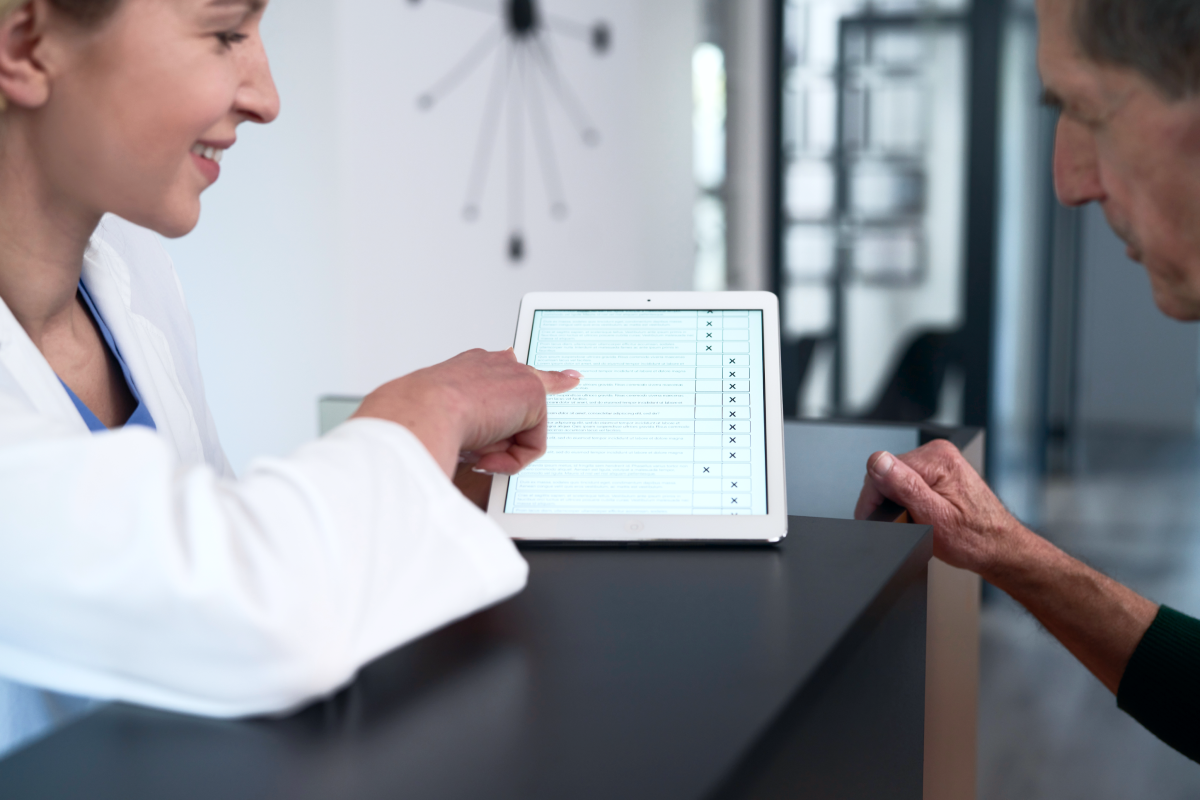Healthcare providers face numerous challenges as they strive to improve the clinical experience for patients and medical professionals alike. Missed appointments, claim rejections, and increased expenditure are some issues that trouble stakeholders in healthcare. But with RPA in healthcare, we expect a sustainable solution.
Already, healthcare RPA is a rapidly growing market. A study predicted it’ll hit $ 14.18 billion by 2032, compared to $1.2 billion in 2022. As RPA adoption grows among medical providers, so does their ability to navigate the complex requirements the industry demands.
In this article, we’ll explore the possibilities of implementing RPA to improve healthcare deliveries. My name is based on the authors, Aliona Nikolaeva, I'm a Project Manager Lead at Uptech. I'll be sharing my expertise in healthcare app development and GenAI, backed by our experience with AI projects like Angler AI, and Dyvo.AI as well as our work in healthcare. This will be a practical and informative piece, so let’s get started!
What is RPA in healthcare?
RPA, which stands for Robotic Process Automation, streamlines end-to-end healthcare operations with software automation technologies. You can think of RPA as a special type of software that bridges the gap between two or more disparate healthcare systems.
When implemented, RPA saves healthcare providers time, money, and resources. Plus, RPA allows medical staff to focus their effort on providing better patient care instead of repetitive and manual tasks. And if you’re leading a medical team, you can expect increased productivity and do away with many time-consuming processes.
How does RPA work?
RPA are software robots, or simply ‘bots’, that can automate operational processes previously undertaken by medical staff. Whether admission, claim processing, or revenue management, healthcare RPA aims to reduce inefficiencies, human errors, and resource wastage.
When deployed, these bots will take over tasks like data entry, information search, and other redundant processes. Rather, the bots enable healthcare automation, which streamlines one system with another seamlessly. They make data sharing easier without needing a medical staff to continuously operate the system.

How can RPA be useful in healthcare from a business perspective?
Medical professionals hope to provide the best healthcare that patients deserve. However, from a business standpoint, cost, sustainability, compliance, and other factors can influence the services they render. With RPA shaping emerging healthcare trends, medical teams can do more with less by automating repetitive and rule-based tasks.
In the result we get improvements across all areas of healthcare operations. Below, we share several benefits of RPA in healthcare that you can expect.

Lower administrative costs
Healthcare RPA, with its ability to replace human forces performing mundane processes, is a major cost-saver. By identifying and automating processes like patient registration, medical coding, and invoicing, clinical practitioners can enjoy a significant cost reduction.
According to Deloitte, RPA can result in up to 59% cost reduction, a strong motivation for healthcare providers to pursue its adoption. Although implementing the RPA in existing systems requires an investment, healthcare providers will enjoy a healthy return over the years.
Reduce the number of human errors
Severe medical errors can compromise patients' safety and result in legal action. Cumulatively, medical errors have cost the healthcare industry up to $45 billion annually. Be it reports summarization, credential verifications, claims submission, or other tasks, there are plenty of errors when they’re solely dependent on humans.
With a well-engineered RPA system, healthcare providers will see a major drop in human errors. These robot-like software mimic their human counterparts in executing the tasks, except that the former isn’t prone to fatigue and delivers consistent results.
Improved patient experience
Delays, mix-ups, and critical errors can negatively impact the care experience and erode patient’s trust. On the flip side, automating healthcare processes with RPA provides more consistent and precise delivery of patient care across all touch points.
Whether it's onboarding, scheduling appointments, or post-treatment care, RPA in healthcare ensures patients are tended to promptly. Compared to conventional systems, patients no longer need to wait as medical staff key in their details, make calls to verify their eligibility, or spend time on other menial tasks.
Faster turnaround times
Paying a visit to the hospital can be a distressing experience for some patients. On top of dealing with their medical conditions, the wait time can be unbearable. For example, confusion in doctor’s schedules means patients must spend additional time before a consultation. Likewise, medical officers might need more time to manually consolidate electronic health records (EHR) from various sources.
RPA, in this case, can make the entire healthcare process more efficient. It eliminates redundancies, saving time for both patients and medical practitioners alike.
Reduce manual workload
Burnout is a critical phenomenon that affects health workers worldwide. If left unaddressed, healthcare employees cannot sustain their ability to provide the best care experience for patients. A practical way to resolve this pressing issue is integrating RPA into existing healthcare systems. For example, healthcare chatbots can answer common questions that were conventionally directed to front-desk officers.
By introducing RPA, medical workers no longer have to take on mundane tasks like scheduling appointments, verifying claims, and tracking medical equipment. Rather, they can focus on higher-value tasks to speed up patient consultation, laboratory reports, treatment, discharge, and other critical processes.
RPA use cases in the healthcare industry
Healthcare robotic process automation is a welcomed technology that many medical providers sorely need. Fueled by generative AI in healthcare, the possibility of RPA applications has grown exponentially. Below are several ways how you can streamline and scale healthcare processes with RPA.

Patient onboarding
Healthcare personnel have to grapple with paperwork, data entry, and other tedious tasks to register a particular patient. During the process, they would need to perform an eligibility check, retrieve EMR, set appointments, and more. All of these tasks consume precious time and human resources that healthcare providers can barely spare.
With RPA in healthcare, there is an opportunity to automate the entire patient onboarding pipeline, freeing up the immense workload that medical staff had to bear. For example, East Lancashire Hospitals NHS Trust, which adopted RPA for GP referrals, managed to process 15,000 appointments per month without the clinician’s intervention.
Authorization management
Most patients depend on their insurers to pay for their treatment charges. That, itself, can be a bottleneck in the healthcare process. When left to manual processing, patients would find themselves in a long wait during eligibility checks and reimbursement.
Medical RPA can significantly accelerate the timeline. Instead of manually cross-checking information with the insurers, the bots deployed can automate all the required tasks. Moreover, there are also no risks of filing mistakes, which can result in claims denial.
Overall, with RPA in place, a patient’s care journey is smoother and less impacted by the layers of the insurer’s stringent check.
Planning patient visits
Healthcare providers strive to accommodate all patient's requests for appointments. However, some still resort to traditional methods — of manually taking appointment calls and penning them down into the calendar. Doing so makes rescheduling extremely difficult and increases the risks of scheduling mistakes.
Robotic process automation for healthcare, on the other hand, can automate appointments by allowing patients to choose from available dates. Then, the bots can update the database after cross-checking with the doctor’s schedule. On top of that, patients can receive reminders by email, text, or automated phone calls of their upcoming visits.
Billing, payments, and claims management
Every treatment, prescription, test, and medical service rendered is billable. The challenge is that they must be reflected accurately on medical bills. Despite their best efforts, medical staff occasionally make mistakes, resulting in rejected claims and revenue losses.
In the US, medical billing errors, including intentional fraud, cost the healthcare industry $68 billion annually. But it doesn’t need to be so. With RPA, patients can enjoy a transparent process when they’re asked to pay for the medical services rendered.
RPA software, coupled with generative AI, can aid medical staff in preparing invoices, applying medical codes, submitting claims, processing payments, and follow-ups.
Learn more about how AI will improve patient care in our blogpost.
Electronic records and data sharing
Medical professionals rely on accurate and comprehensive EMR to diagnose, treat, and prescribe patients they onboarded. Consolidating the medical records and sharing them across departments proves to be a challenge. Failure to ensure timely access to medical information can result in duplicate tests, delayed treatment, and other mistakes.
Healthcare process automation, when applied in EMR management systems, streamlines efforts to consolidate and share medical data. When coupled with technologies like optical character recognition and generative AI, clinicians can compile medical information from both digital and physical sources into a unified database.
Audit and compliance requirements
Healthcare providers must comply with strict regulations like HIPAA, GDPR, and CCPA or risk hefty penalties. This involves periodically auditing medical records, operational processes, and other documents. When performed manually, such tasks are riddled with inefficiency and rob clinical practitioners of valuable time.
However, when they shift to healthcare robotic process automation, auditing is much easier. Medical staff are aided by data analytics, allowing them to categorize, inspect, and manage audit results on a user-friendly interface. On top of that, bots can automatically flag non-compliance in existing records and apply appropriate remediation without human intervention.
Revenue cycle management
Medical staff go through a time-consuming process to inventorize every medical service a patient receives. Often, this means filing and cross-checking information on disparate systems when consolidating treatment data, filing invoices, and submitting claims. Mistakes in any part of the billing cycle can result in overcharges or delays in revenue collections.
RPA can assist healthcare establishments in setting up a transparent yet efficient revenue collection pipeline. Amongst practical RPA applications in healthcare are automating information extraction from patient records, integrating with the insurer’s database, remitting due payments, and reminding patients of their billables. On top of that, finance departments can easily extract revenue data with RPA bots to get a holistic view of their financial standings.
Healthcare insurance document automation
Mistakes that occur when preparing insurance documents can result in denials. In fact, a survey showed that at least 10% of patients are denied their claims. Such incidents lead to costly reworks as medical workers attempt to re-file the claims. For hospitals and other care facilities, a high denial rate will affect their revenue collections.
Healthcare RPA reduces the chances of rejections from insurers by getting the claims prepared accurately. Software bots, when deployed, can extract medical data from various sources. They also excel in matching medical services to their respective medical codes, detecting discrepancies, and tracking the claim status.
Inventory and supply chain management
Medical officers couldn’t afford to spend excessive time finding the equipment they needed to facilitate patient treatment. Likewise, medicines and other healthcare essentials must be accountable and available at all times. Without a unified management system, patient care might be compromised by insufficient, faulty, or expired medical resources.
Here, integrating robotic process automation across the medical logistics and supply chain can help. A fully operational RPA software, paired with IoT sensors, allows hospitals to track inventory movements accurately. By analyzing historical usage data, medical workers can preempt equipment failure, stock up on fast-moving items, and allocate them to respective departments.
Opportunities of Adopting RPA In Healthcare
Healthcare providers stand to benefit from all fronts when they adopt RPA to augment existing medical workflows. These are some possibilities that medical RPA would enable.
Enhanced data security
RPA healthcare software safeguards healthcare companies against digital threats and protects patient’s privacy. Through technologies like encryption, secure storage, and authentication, RPA improves the organization’s cyber resilience, ensuring continuous adherence to data privacy laws like HIPAA and GDPR.
Scalability
RPA enables healthcare companies to scale their services to meet growing demands without committing excessive resources. It unifies disparate medical systems through integrations that allow seamless and secure exchange, promoting efficiency, waste reduction, and cost-friendliness.
Clinical data insights
RPA applications in healthcare enable medical professionals to extract patient data from various sources without technical complications. It allows doctors, nurses, and medical staff to access the information they’re authorized to and share it with co-workers from a single dashboard.
Financial oversight
RPA bots provide clarity on accounts, claims, receivables, liabilities, and other finance indicators. They automatically extract financial data and consolidate them, which allows stakeholders to manage revenue and expenses more effectively.
Excellent patient care delivery
RPA in healthcare boosts patient experience when integrated with CRMs that hospitals use. It makes patient care delivery more efficient at all touchpoints, reduces mistakes, and ensures medical staff devote their utmost attention to rendering healthcare services.
Explore how to get started with healthcare CRM development here.
Appointment scheduling
Patients, through healthcare automation systems, can schedule medical appointments without contacting the front service desk. RPA enables them to check doctor’s availability, make an appointment, reschedule, and receive alerts conveniently through the web, mobile apps, or AI-owered virtual healthcare chatbots.
Human resource management
RPA for healthcare improves employee satisfaction through prompt and accurate calculation of timesheets, remuneration, leaves, and other perks. Such technologies can also be used to support performance reviews and crafting career growth plans in the medical sector.
Obstacles of Adopting RPA in Healthcare
Medical RPA implementation can bring organization-wide benefits in the long run, but doing so isn’t without challenges. Before you build or integrate RPA software with existing healthcare systems, be mindful of these potential hurdles.

Lack of clear RPA adoption strategy
Problem: Healthcare systems are complex and interconnected. Not knowing which process to automate or how to even get started can cause resistance, confusion, and flawed adoption.
Solution: All stakeholders must hold discussions to identify goals in their RPA strategy. Specifically, outlining areas to automate, measuring success, and planning a gradual rollout is pivotal to success.
Compliance and integration
Problem: Healthcare providers might find adhering to data privacy acts challenging as they integrate RPA services for healthcare with disparate or legacy systems. This potentially increases data privacy risks and invites penalties from regulatory bodies.
Solution: Make compliance a priority throughout the entire implementation. Set up a compliance committee to audit your process, ensuring all requirements are met.
Data security and privacy
Problem: An RPA healthcare system collects, stores, and processes sensitive medical data, which makes it a likely target for cybercriminals. Data breaches and other digital risks could compromise patient’s trust and result in financial losses.
Solution: Apply data security measures like encryptions, multi-factor authentication, and role-based access to prevent cybercriminal attempts and accidental data leakages.
Lack of technical expertise
Problem: When you build a medical RPA, you need expertise in software technologies, data analysis, generative AI, compliance, and healthcare. Many medical establishments struggle to hire and manage the right talents to implement an RPA system.
Solution: One way to overcome the challenge is to invest in in-house hiring and training. Alternatively, healthcare providers can consider partnering with experienced software development agencies to build, deploy, and maintain the RPA software.
Post-deployment issues
Problem: Operational processes, compliance requirements, and other criteria might change after the RPA is deployed. Unless healthcare providers can update the bots promptly, they might be challenged by non-compliance and delays.
Solution: It’s best to allocate a dedicated support team to oversee the RPA software after it’s operational. If you partner with an RPA development vendor, they can assist in deploying subsequent updates and address any issues that arise.

Uptech Tips for Adopting RPA in Healthcare
Although RPA adoption is not without challenges, you can avoid specific hurdles with thoughtful planning and implementation. At Uptech, we’ve helped healthcare companies build apps that feature RPA capabilities. We share some tips that will help you adopt medical RPA more smoothly.
1. Study the current workflow and gather stakeholder feedback
The first thing to do is to examine your current operational process. It’s imperative to understand that each establishment has its respective workflows. Therefore, inspect your patient onboarding, lab testing, prescription, post-discharge treatment, billings, and other processes to identify inefficiencies that RPA will solve.
Also, RPA adoption is an exercise that requires input from all stakeholders. So, conduct in-depth discussions with doctors, nurses, medical workers, administrative teams, board of directors, and other parties. Make sure all the parties share the same vision and expectations towards adopting RPA.
2. Plan the adoption
Take time to plan how you will implement the RPA. That includes allocating budget, assessing integration risks, meeting compliance requirements, and acquiring technical expertise. More importantly, create a schedule that allows gradual implementation to prevent disruption to the existing healthcare systems.
3. Choose only suitable tasks for automation
Not all healthcare systems need to be automated. If an existing process is already proven efficient, integrating RPA bots will have little to no benefits. Therefore, do a thorough audit of the entire system and pinpoint processes that will potentially improve significantly with bots.
4. Start with a proof of concept
It’s tempting to roll out RPA bots across the entire healthcare system in one go. But doing this is risky without knowing if they’ll be a right fit for medical users. Rather, develop a PoC to gather feedback and validate preliminary assumptions before moving further.
Once your PoC has proven that RPA medical systems will impact the respective healthcare processes, begin building it. But remember, prioritize compliance, data security, and patient privacy throughout. Don’t release the RPA software until it’s properly tested for bugs, vulnerabilities, and other technical issues.
5. Monitor and optimize RPA after deployment
After the RPA has gone operational, continue to gather feedback, make improvements, and resolve teething issues. Be aware of fast-changing compliance requirements, bugs, and emerging trends in AI. Make changes as you deem fit. Eventually, the goal is to ensure the RPA remains helpful and secure for patients and medical staff alike.
FAQ
What is RPA in healthcare implementation costs?
The cost of rolling out RPA software depends on several factors, including development complexity, cloud infrastructure, integration, and post-deployment support. Because RPA implementation usually involves automating various components in a healthcare system, the cost might go up to $500,000 or more.
What are the real-life examples of RPA in healthcare?
If you need references for healthcare providers applying RPA, check out these examples.
- Max Healthcare invested in RPA for many use cases, including patient onboarding, claim processing, and pharmacy management. They witnessed improvement in patient care quality because of the accuracy and consistency that RPA bots offer.
- Nottingham University used robotic bots to replace humans to monitor oxygen levels when treating COVID-19 patients. Previously, medical workers had to manually read the level every hour, but with RPA, the process is fully automated.
- GAM ,a leading pharmaceutical company in Brazil, uses RPA to replace error-prone data entry tasks. As a result, staff can divert their time to managing vendors and other high-value activities instead of filling up forms.
How quickly can an RPA solution pay off?
Understandably, healthcare companies need to justify their investments before implementing RPA. So far, studies have shown encouraging results. Deloitte, for example, reported that medical RPA can reduce business process costs by up to 40%. Meanwhile, McKinsey stated that organizations can potentially chart a 30% - 200% ROI within the first year.
What are popular RPA platforms for healthcare?
Some common RPA platforms that let health providers quickly automate their processes are UiPath, Blue Prism, and Microsoft Power Automate. These platforms provide ready-to-use automation templates, data security, and AI-powered features.
However, off-the-shelf platforms are often limited in terms of scalability. Most medical establishments require customized capabilities that fit into their existing workflows. In that case, partnering with a healthcare software development services provider is better.
Can RPA disrupt the current workflows at a clinic?
Yes. You can expect positive changes in a clinic’s workflow if the RPA integration is carried out effectively. With robotic software bots in place, there will be fewer human errors, improved efficiency, and reduced cost. At the same time, the medical workforce might need time to familiarize themselves with the RPA upgrades, which cause temporary productivity losses.




































































































